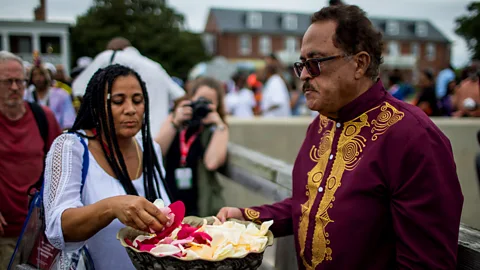Calvin Pearson: Rewriting Black History with Project 1619

Discover the captivating story of Calvin Pearson, the visionary founder of Project 1619, who has dedicated himself to rewriting Black history in America. Unearthing groundbreaking evidence, Pearson shattered long-held beliefs by revealing that the first Africans did not arrive in Jamestown, but rather at Point Comfort, now known as Fort Monroe, in Virginia in 1619. Through his persistent research and passionate presentations, Pearson successfully convinced the Virginia Department of Historic Resources to amend historical signs, acknowledging Fort Monroe as the true birthplace of Black American culture. This remarkable site served as a refuge for escaped enslaved Black people during the US Civil War and eventually became the first self-contained Black community in the country. Today, Fort Monroe stands as a National Monument, welcoming visitors to explore its rich history and plans are in motion to honor the African landing with a new memorial. Join the journey as Calvin Pearson shines a light on the forgotten chapters of the African American experience.

Calvin Pearson: Founder of Project 1619
Background of Calvin Pearson
Calvin Pearson is a renowned historian and the founder of Project 1619. With a keen interest in Black history, Pearson has dedicated his life to uncovering the true narrative of the first Africans’ arrival in the British Colonies. His research has challenged the previous beliefs and shed light on the significance of Point Comfort in Virginia. Pearson’s work has not only corrected historical inaccuracies but has also played a crucial role in reshaping our understanding of Black history in America.
Mission behind Project 1619
The mission of Project 1619 is to rewrite Black history by revealing the accurate account of the first Africans’ arrival and their impact on American society. Pearson’s goal is to ensure that the contributions and struggles of African Americans are properly recognized and integrated into the larger historical narrative. By shining a spotlight on Point Comfort, Pearson aims to educate and empower individuals to embrace the rich heritage of Black Americans and foster a more inclusive understanding of American history.
Discovery of the first Africans’ arrival
Through meticulous research and extensive examination of historical archives, Calvin Pearson made a groundbreaking discovery. Previously, it was widely believed that the first Africans arrived at Jamestown, Virginia in 1619. However, Pearson’s findings revealed that the true landing site was actually Point Comfort, which is now known as Fort Monroe. This discovery challenged the long-standing narrative and sparked a reevaluation of Black history in America.
Rewriting Black History
Challenging the previous narrative
By challenging the previous narrative and presenting his findings to the Virginia Department of Historic Resources in 1996, Calvin Pearson initiated a paradigm shift in our understanding of the first Africans’ arrival. His research provided concrete evidence that Point Comfort was the true landing site, allowing for a more accurate interpretation of history. Pearson’s work opens doors to new perspectives and insights, encouraging a reexamination of existing knowledge and understanding.
Significance of Point Comfort
Point Comfort holds immense significance in Black American history. As the first point of arrival for Africans in the British Colonies, it symbolizes the beginning of a new chapter that would profoundly shape the trajectory of American society. The landing at Point Comfort marked the start of a long and arduous journey for African Americans, one that would witness their struggles, resilience, and contributions to the fabric of American culture. Understanding the true significance of Point Comfort allows us to appreciate the depth and complexity of Black history in America.
Correction of historical signs at Jamestown and Fort Monroe
Upon presenting his research, Calvin Pearson’s findings prompted a correction of historical signs at both Jamestown and Fort Monroe. The revised signs now accurately reflect the information uncovered by Pearson, providing visitors with a more accurate and comprehensive understanding of the first Africans’ arrival. This correction not only rectifies the historical record but also demonstrates the importance of continuous research and the willingness to reevaluate existing narratives in order to paint a more accurate picture of history.

Point Comfort: Ground Zero for Black American Culture
Location and historical importance
Point Comfort, now known as Fort Monroe, is a historic location with deep-rooted significance in Black American culture. Situated in Hampton, Virginia, it stands on a point of land that extends into the Chesapeake Bay. The geographical location played a crucial role in the transatlantic slave trade and later became a symbol of hope and liberation for African Americans.
Connection to African American heritage
Point Comfort serves as a connection point to African American heritage, allowing individuals to trace their roots and understand the experiences of their ancestors. The recognition of Point Comfort as the true landing site for the first Africans demonstrates the importance of acknowledging and preserving African American history, ensuring that it is not overshadowed or forgotten.
Role in the history of African Americans
Point Comfort played a pivotal role in the history of African Americans. It was here that the first Africans were forced into slavery, marking the beginning of a long and painful chapter in American history. The struggles, resilience, and resistance that originated at Point Comfort paved the way for the generations of African Americans who would fight for freedom, equality, and justice. By understanding the significance of Point Comfort, we can appreciate the complex legacy of African Americans and honor the contributions they have made to society.

Fort Monroe: A Refuge and Self-Contained Black Community
Refuge for escaped enslaved Black people
Fort Monroe, located at the site of Point Comfort, served as a place of refuge for escaped enslaved Black people during the US Civil War. As the war progressed, thousands sought safety within the walls of Fort Monroe, escaping the chains of slavery and seeking freedom. The fort’s unique position as a stronghold for the Union Army made it a sanctuary for those fleeing the horrors of bondage.
Formation of the first self-contained Black community in the US
The arrival of escaped enslaved Black people at Fort Monroe led to the formation of the first self-contained Black community in the United States. Known as the “Great Contraband Camp,” this community within the fort’s boundaries was a place of solace, strength, and empowerment. It provided the foundation for the emancipation and liberation of African Americans, marking a turning point in their struggle for equality.
Importance during the US Civil War
Fort Monroe played a significant role during the US Civil War as a Union stronghold. Its strategic location on the Chesapeake Bay made it an important military asset. The fort’s capture by Union forces early in the war ensured that the surrounding area, including the contraband camp, became a sanctuary for escaped enslaved African Americans seeking freedom. Fort Monroe’s presence and subsequent transformation into a self-contained Black community became a symbol of hope and the fight against slavery.

Fort Monroe as a National Monument
Recognition of historical significance
In recognition of its historical significance, Fort Monroe was designated a National Monument. This status attests to the importance of the fort in shaping the narrative of Black American history and its role in the fight for freedom and equality. It serves as a tangible reminder of the struggles endured and the triumphs achieved by African Americans throughout history.
Inclusion of the Great Contraband Camp and Emancipation Oak
The National Monument status of Fort Monroe includes not only the fort itself but also the Great Contraband Camp and the iconic Emancipation Oak. These sites are integral parts of the African American story and represent the resilience and determination of those who sought freedom and justice. The inclusion of these locations highlights the significance of Fort Monroe and its connection to Black American history.
Preservation efforts
Efforts to preserve Fort Monroe and its historical significance are ongoing. The designation as a National Monument ensures that the fort and its associated sites are protected for future generations to experience and learn from. Preservation initiatives aim to maintain the integrity of the fort’s architectural features and commemorate the struggles endured by African Americans who found solace within its walls.

Efforts to Attract Visitors
Promoting tourism at Fort Monroe
To attract visitors and raise awareness of Fort Monroe’s historical significance, various initiatives are in place. Tours, exhibits, and educational programs offer visitors a chance to immerse themselves in the complex history of African Americans at Fort Monroe. These efforts aim to bring attention to the importance of Fort Monroe as a site of national and cultural significance.
Planning of the African Landing Memorial
As part of ongoing efforts to attract visitors, plans are underway for the construction of the African Landing Memorial at Fort Monroe. This memorial will honor and commemorate the first Africans who arrived at Point Comfort in 1619 and the subsequent impact they had on American society. The memorial will serve as a powerful reminder of the struggles and triumphs of African Americans throughout history, inviting visitors to reflect on the legacy of those who came before us.
Enhancing accessibility and awareness
To ensure that Fort Monroe remains accessible to all, efforts are being made to enhance accessibility and raise awareness. Collaborations with community organizations, schools, and universities aim to engage a diverse range of visitors and foster a sense of inclusivity. By making Fort Monroe’s history more widely known and accessible, these efforts contribute to a more comprehensive understanding of American history and promote cultural exchange and appreciation.
In conclusion, Calvin Pearson’s research and dedication to rewriting Black history have paved the way for a deeper understanding of the first Africans’ arrival and the impact of African Americans on American society. Through his work with Project 1619, Pearson has challenged and corrected historical narratives, resulting in a more accurate portrayal of Black history. Point Comfort, now recognized as ground zero for Black American culture, and Fort Monroe, with its historical and cultural significance, stand as testaments to the resilience, struggles, and triumphs of African Americans throughout history. Efforts to attract visitors to Fort Monroe and raise awareness of its importance ensure that the legacy of African Americans continues to be celebrated and remembered for generations to come.










